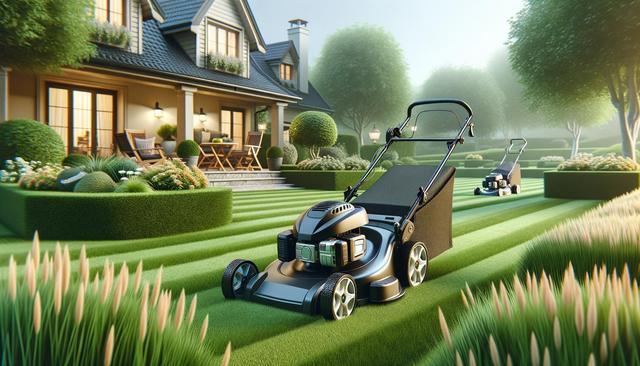Understanding the Importance of Lawn Mowing
Lawn mowing isn’t just about keeping your yard neat—it’s a crucial practice for maintaining the health of your grass. Regular mowing helps strengthen the grass roots, encourages even growth, and prevents weeds from taking over. When done properly, mowing can enhance your lawn’s resilience to drought and pests. It’s important to understand that each type of grass has an ideal height for mowing, and cutting it too short can lead to stress and damage. For instance, cool-season grasses typically do best when kept between 2.5 to 4 inches tall, while warm-season varieties often thrive at slightly shorter heights.
Moreover, consistent mowing helps distribute nutrients more evenly across your lawn. Grass clippings, when left on the lawn in moderation, decompose and return valuable nitrogen back into the soil. This natural fertilization reduces the need for chemical treatments, making your lawn care routine more sustainable and environmentally friendly.
Choosing the Right Equipment for the Job
The effectiveness of your lawn mowing largely depends on the equipment you use. There are several types of lawn mowers, each suited to different yard sizes and terrain types. For small to medium lawns, a push mower or electric mower can be efficient and easy to handle. Larger properties, on the other hand, may require a riding mower for faster and more comfortable mowing.
When selecting a mower, consider the following factors:
- Yard size and slope
- Power source preference (gas, electric, battery)
- Cutting width and height adjustment options
- Ease of maintenance and blade sharpening
Regular maintenance of your mower is equally essential. Dull blades can tear the grass, leaving ragged edges that are more vulnerable to disease. Cleaning the mower deck and checking oil levels also help ensure your machine stays in top condition throughout the mowing season.
Timing and Frequency Matter
Timing your mowing sessions correctly can make a significant difference in lawn health. It’s recommended to mow when the grass is dry, as wet grass can clog your mower and create uneven cuts. Early evening or late morning, when the sun isn’t too harsh, is usually the best time to mow. Avoid mowing during the heat of the day, as this can stress both the grass and the person operating the mower.
The frequency of mowing depends on how quickly your grass grows, which can vary with the seasons. During the peak growing season, you might need to mow once a week, while in cooler or drier months, every two weeks may be sufficient. A good rule of thumb is to never cut more than one-third of the grass blade at a time. This helps prevent shock and allows the grass to recover more quickly.
Regular mowing also helps you keep an eye out for signs of lawn issues, such as uneven growth, bald patches, or pest infestations. Addressing these problems early can save you time and money in the long run.
Techniques for a Professional Finish
Even if you’re mowing your lawn yourself, there are techniques you can use to achieve a cleaner, more professional look. One such method is changing your mowing pattern regularly. This prevents the grass from leaning in one direction and minimizes soil compaction. Alternating between horizontal, vertical, and diagonal patterns also adds visual interest to your lawn.
Another helpful tip is to overlap each pass slightly to avoid missing spots. If your mower has a mulching function, you can use it to finely chop the clippings and distribute them evenly. This not only returns nutrients to the soil but also helps with moisture retention. For lawns with edges and borders, using a trimmer after mowing can give your yard a crisp, well-maintained appearance.
Additionally, here are a few finishing tips:
- Sharpen your mower blades at least once per season
- Clean your mower after each use to prevent rust and buildup
- Inspect your lawn for obstacles before mowing to avoid damage
By adopting these techniques, your lawn will not only look better, but it will also stay healthier over time.
Environmental Considerations and Safety Tips
Lawn mowing, while routine, should always be carried out with safety and the environment in mind. Gas-powered mowers emit pollutants, so opting for electric or battery-powered models can reduce your carbon footprint. If a traditional mower is necessary, consider using one that meets EPA emission standards to minimize environmental harm.
Grass clippings can be reused in several eco-friendly ways. Aside from leaving them on the lawn as mulch, they can be added to compost bins to enrich your garden soil. Avoid sending clippings to landfills where they contribute to methane emissions. Also, be mindful of water conservation. A well-mowed lawn retains moisture more effectively, reducing the need for frequent watering.
For safety, always wear appropriate footwear and eye protection when mowing. Keep children and pets indoors or at a safe distance during operation. Before starting, check the lawn for debris like branches or stones that could damage your mower or cause injury. Never attempt to clear clogs or adjust the mower while it’s running, and always follow the manufacturer’s instructions for safe use.
Conclusion: Maintaining a Lawn You Can Be Proud Of
Keeping your lawn mowed isn’t just about appearances—it’s about cultivating a space that’s healthy, functional, and enjoyable. By understanding proper mowing practices, choosing suitable equipment, and paying attention to timing and technique, you can ensure your lawn remains in excellent condition. Whether you’re a seasoned homeowner or just getting started with lawn care, a thoughtful approach to mowing can make all the difference in creating a vibrant outdoor environment you can take pride in.




Leave a Reply